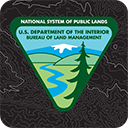Citizen scientists reveal subterranean resources in need of protection
Heather Feeney, Bureau of Land Management
In past decades science has been a process of exploration, of being the first to venture to remote, extreme or exotic places, or to unlock the hidden workings of nature.
In our time, more than 100 feet below a Montana mountain range, citizen scientists are questing for knowledge with an added responsibility — helping protect and conserve the beautiful natural places they explore.
Professional scientists — mainly archaeologists — took an interest in the caves of the Pryor Mountains in the 1930s and 40s to investigate the formations’ place in the lives of Montana’s early hunter-gatherer people. More recently, citizen scientists are using powerful, low-impact technology to develop monitoring protocols that support safe, sustainable recreational use and protect the caves’ geology and ecology.
Mystery Cave’s flowstone, stalactites and stalagmites draw recreational visitors, and its passageways are home for the Townsend’s big-eared bat (Corynorhinus townsendii). The Bureau of Land Management (BLM) turns to science when planning to manage the cave for sustainable use of these various resources, and two groups have worked to provide that scientific information.
In 2014 members of the Northern Rocky Mountain Grotto mapped Mystery Cave. Eleven members ran survey lines totaling 3,327 feet and recorded a maximum depth of 154 feet. The Bigfork High School Cave Club — whose faculty advisor, Hans Bodenhamer, is a Grotto member and a renowned cave-mapping expert — followed in 2017 with GPS, temperature sensors and digital cameras to record the cave’s various resources, while documenting impacts from unregulated visits in the past.
From the datapoints of unusual mineral deposits and specialized wildlife habitats, pathways for future recreational adventure emerge. “The Mystery Cave data provides a basic map for a trail system,” says Jenny Alexander, outdoor recreation planner for the BLM Billings Field Office, “and we now also have a set of best practices for doing the inventory and monitoring of cave and karst resources required in our resource management plan.”
The students took the Grotto’s base map and located, photographed and assessed the condition of various resources they observed in the cave, recording climatological and mineral data, bat sightings, graffiti, and other information at all three of the cave’s depth-levels. Bodenhamer says collecting the monitoring data from territory that had been mostly uncharted took an eight-student crew three days of field work plus at least five times as many hours back in his classroom to input into GIS and present on a website.
“High school students aren’t always thought of as being capable, but they are in fact an untapped resource of intellect and energy,” Bodenhamer says. He reflects on the way in which the Cave Club has evolved from an afterschool activity to a component of his science classes at the high school in Flathead County. “I think the thrill of exploration should be maintained but also be well connected with the responsibility that we, as explorers, have to conserve and protect beautiful natural places.”
The BLM Billings Field Office is using the data to draft a cave management plan that will guide public access to Mystery Cave for recreation while minimizing impacts from visitation: in particular, helping guard against resource damage from excessive or careless use and ensuring that white-nose syndrome (WNS) does not infect the bats in this cave or others in the area.
The Bigfork Cave Club plans to be back in the field this summer to accomplish more monitoring in cooperation with the BLM and U.S. Forest Service (USFS). While field work was curtailed in 2020 during the coronavirus pandemic, the group was able to identify additional caves in the Pryor Mountains that may be eligible for Significant designation under the Federal Cave Resource Protection Act.
USFS geologist Dan Seifert, who works with the club and the BLM to inventory and monitor caves on the adjacent Custer Gallatin National Forest, says that the Act has a word or two about citizen science. “A purpose of the act is ‘to foster increased cooperation and exchange of information between governmental authorities and those who utilize caves located on Federal lands for scientific, education, or recreational purposes.’ It basically directs Federal agencies to engage in citizen science.”
As the science coordinator for the BLM National Conservation Lands, Fritz Klasner also leads the agency’s Citizen Science program. He notes the value of efforts like monitoring Mystery Cave beyond the immediate utility of the knowledge gained. “With a citizen science project, community involvement strengthens community advocacy for using their science and other scientific insights in management and planning.”
Hans Bodenhamer sees this with his students. “They gain real world experience in using the applications of field science, practice using technologies such as GIS, and develop skills in technical writing and public speaking. They also know they are involved in something that is real and will actually help managers conserve natural resources.”
